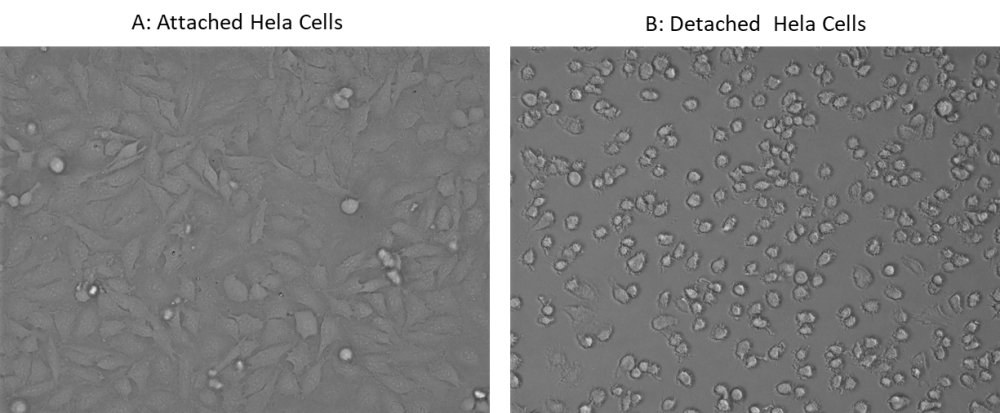El buffer de separación de células ReadiUse™ es muy útil para el paso celular de rutina, el análisis de marcadores y receptores de la superficie celular, la proliferación celular, la apoptosis y la citometría de flujo.
Descripción
El buffer de separación de células ReadiUse™ es una solución de desprendimiento de células que no contiene productos derivados de mamíferos o bacterias. Funciona de manera similar a la tripsina con un efecto mucho menos tóxico. Funciona excepcionalmente bien en la separación de células primarias y células madre y mantiene una alta viabilidad celular. El buffer de separación de células ReadiUse™ es muy útil para el paso celular de rutina, el análisis de marcadores y receptores de la superficie celular, la proliferación celular, la apoptosis y la citometría de flujo.
Nombre en Ingles: ReadiUse™ Cell Detaching Buffer
| Catalogo | Producto | Presentación |
|---|---|---|
| AAT-60010 | Buffer de separación de células ReadiUse™ | 50 ml |
Importante, Solo para uso en investigación (RUO).
Condiciones de almacenamiento y manipulación
El buffer de separación de células ReadiUse™ se suministra como un líquido congelado, estéril y listo para usar. Una vez descongelado, se puede conservar hasta 2 meses a 4 °C. Proteja el producto de la luz.
Imagenes

Figura 1. Separación de células Hela con el buffer ReadiUse™.
Productos Relacionados
Bibliografía
Ver todas las 30 bibliografias: Citation Explorer
A Simple Cell-based Immunofluorescence Assay to Detect Autoantibody Against the N-Methyl-D-Aspartate (NMDA) Receptor in Blood
Authors: Chen, C. H., Chang, Y. S.
Journal: J Vis Exp (2018): se name=”60010.enl” path=”C:\Website\Referenc
The virtual cell based assay: Current status and future perspectives
Authors: Graepel, R., Lamon, L., Asturiol, D., Berggren, E., Joossens, E., Paini, A., Prieto, P., Whelan, M., Worth, A.
Journal: Toxicol In Vitro (2017): 258-267
Evaluation of anti-Zika virus activities of broad-spectrum antivirals and NIH clinical collection compounds using a cell-based, high-throughput screen assay
Authors: Adcock, R. S., Chu, Y. K., Golden, J. E., Chung, D. H.
Journal: Antiviral Res (2017): 47-56
A cell-based high-throughput screening assay system for inhibitor compounds of antigen presentation by HLA class II molecule
Authors: Watanabe, N., Suzuki, Y., Yonezu, T., Nakagawa, Y., Shiina, T., Hirayama, N., Inokuchi, S., Inoue, S.
Journal: Sci Rep (2017): 6798
Fluorescent Parkin Cell-Based Assay Development for the Screening of Drugs against Parkinson Disease
Authors: Villace, P., Mella, R. M., Roura-Ferrer, M., Valcarcel, M., Salado, C., Castilla, A., Kortazar, D.
Journal: SLAS Discov (2017): 67-76
Establishment of Cell-Based Neuroglobin Promoter Reporter Assay for Neuroprotective Compounds Screening
Authors: Liu, N., Yu, Z., Gao, X., Song, Y. S., Yuan, J., Xun, Y., Wang, T., Yan, F., Yuan, S., Zhang, J., Xiang, S., Lo, E. H., Wang, X.
Journal: CNS Neurol Disord Drug Targets (2016): 629-39
A cell-based screening assay to identify pharmaceutical compounds that enhance the regenerative quality of corneal repair
Authors: Gordon, G. M., LaGier, A. J., Ponchel, C., Bauskar, A., Itakura, T., Jeong, S., Patel, N., Fini, M. E.
Journal: Wound Repair Regen (2016): 89-99
Cell-Based Assay for Identifying the Modulators of Antioxidant Response Element Signaling Pathway
Authors: Zhao, J., Shukla, S. J., Xia, M.
Journal: Methods Mol Biol (2016): 55-62
Validation of a human cell based high-throughput genotoxicity assay 'Anthem's Genotoxicity screen' using ECVAM recommended lists of genotoxic and non-genotoxic chemicals
Authors: Rajakrishna, L., Krishnan Unni, S., Subbiah, M., Sadagopan, S., Nair, A. R., Ch and rappa, R., Sambasivam, G., Sukumaran, S. K.
Journal: Toxicol In Vitro (2014): 46-53
Development of a novel cell-based assay system EPISSAY for screening epigenetic drugs and liposome formulated decitabine
Authors: Lim, S. P., Kumar, R., Akkamsetty, Y., Wang, W., Ho, K., Neilsen, P. M., Walther, D. J., Suetani, R. J., Prestidge, C., Callen, D. F.
Journal: BMC Cancer (2013): 113
Application Notes
Annexin V
Cell Loading Protocol For Fluorescent pH Indicator, BCECF-AM
Experimental Protocol for Calcein AM Assay
How to quantitate ATP induced calcium flux inside mammalian cells using fluorescent calcium indicators
Optimization of Electrophoresis Gel Concentration
FAQ
How can I lyse my cells without lysing the nuclear membrane?
How do you permeabilize a cell?
How Does Protein Purification Work?
How does the fixed cell viability staining dyes work?
How to lyse cells?
AssayWise
Glycerol 3-Phosphate Assays
Thiol Detection
Selecting the right ROS probe
Product Spotlight
A Simple End-Point Calcium Assay Using a Green Fluorescent Indicator Fluo-8E™, AM


